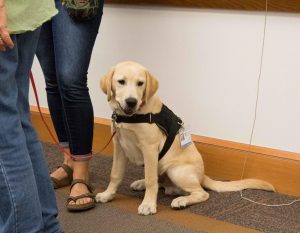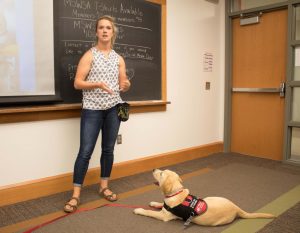Therapy dogs visit UNI campus
Sep 25, 2017
Susan Vallem, a retired professor from Wartburg College came to UNI on Thursday, Sept. 21, to present to students, mainly those who major in social work, about animal assisted therapy and the organization Retrieving Freedom.
Retrieving Freedom trains dogs to help military veterans and children with autism. Sara Shadid, a case worker at Lutheran Services and an intern at Retrieving Freedom, also shared some information about her experience with raising and training the dogs, as well as some insight on what the Retrieving Freedom organization does to help people.
Shadid brought in Levi, the golden retriever she is currently training. Retrieving Freedom begins training dogs when they are eight weeks old. The trainer is responsible for socializing the dog and teaching them basic manners. They are then taught how to work with military veterans and children on the autism spectrum.
“Children on the autism spectrum will tend to bolt when they see things,” Shadid said.
Indicating the rings on Levi’s harness, she said, “So Levi will be attached to a child on one of these rings, and any time that child tries to bolt Levi will lay down and act as that anchor so that child can’t go anywhere.”
Shadid explained that the dogs help children affected by autism physically and mentally. It helps them build friendships and have an understanding that the dog belongs to them. Shadid made a connection to a family that will be receiving one of these dogs soon.
“The mom is saying the child is already asking for Rex. The child has a super hard time bonding with things and building that relationship,” Shadid said. “The child also has a hard time interacting with his siblings, and all weekend the child was laying on a bed with his siblings, playing with the dog with his siblings, and the mom has never seen that before. So, that is a huge step for only having the dog in their home for one weekend.”
The dogs are also being trained to help military veterans that have PTSD and veterans who are disabled.
“We do a lot of behavioral interruptions,” Shadid said. “If the veteran is rubbing their hands or about to have a flashback, that dog will come in and nudge with their nose to say, ‘Hey, I’m right here. Pay attention to me. Get out of your own head. I’m going to lick your hands, I’m going to jump up on your lap and I’m going to be right here to get you through it.’”
The dogs also do this when a veteran is having a nightmare. If they are tossing and turning, the dog is trained to sit on the veteran’s chest and wake them up so they realize they are safe and at home.
The dogs for veterans are also trained to help if the person is disabled. They are trained to push handicap buttons to open doors, retrieve prosthetic limbs and brace. Shadid explained that when a dog braces, it helps its owner get back up. The dog will stiffen its back like a table so the person can use the dog to return to a standing position.
Kazek Israni-Winger, a sophomore digital media productions major, attended the event.
“It’s pretty cool how the people affected by PTSD use the animals as support, and the same with kids affected by autism — that if the kid wants to run somewhere, the dog knows what to do,” Israni-Winger said.
Many different kinds of animals can be used for therapy.
“I even had a college [student] who had a chicken,” Vallem said. “And she would take her to the nursing home. She was a really nifty chicken. […] She could go in, and if someone grew up on a farm she could say, ‘Do you remember having animals on your farm?’ ‘Tell me about that.’ It is a lot of validation therapy — a way of helping them remember good times in their lives since not everyone is really thrilled about going into a nursing home even if it’s for the better.”
Shawna Eischeid, senior social work major, was excited by the fact that anybody could register their animal to work with people.
“I didn’t know you could register online to have your own animal be a part of this or become certified as an animal assisted therapist,” Eischeid said.
People use the animal assisted therapy pets for various ailments such as depression, loneliness, mental illness, disabilities and memory loss, to name a few.
The animals work well with people of all ages. They enhance their communication skills because the dog acts as their support system, as well as serving as a conversation starter among other people.
Vallem noted how a person may talk more to an animal than they would a person, allowing them to comfortably talk about what is going on in their head.
“For many of our kids, weight is helpful,” Vallem said. “Particularly with our hyperactive kiddos or kids on the autism spectrum, that kind of closeness that won’t work with people, but the weight of that animal on their lap, is really really calming as well.”
Retrieving Freedom is a new organization, so they have yet to come across the issue of a dog passing away. According to Shadid, they are coming up with plans as their dogs get older.
Retrieving Freedom would most likely retire an assisted therapy dog at around eight or 10 years of age, depending on the dog’s health. They would then either pair the person with a new dog, or complete the ultimate goal of helping them become independent enough that they no longer need an animal compainion.











